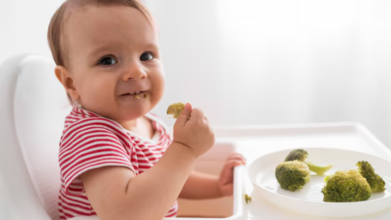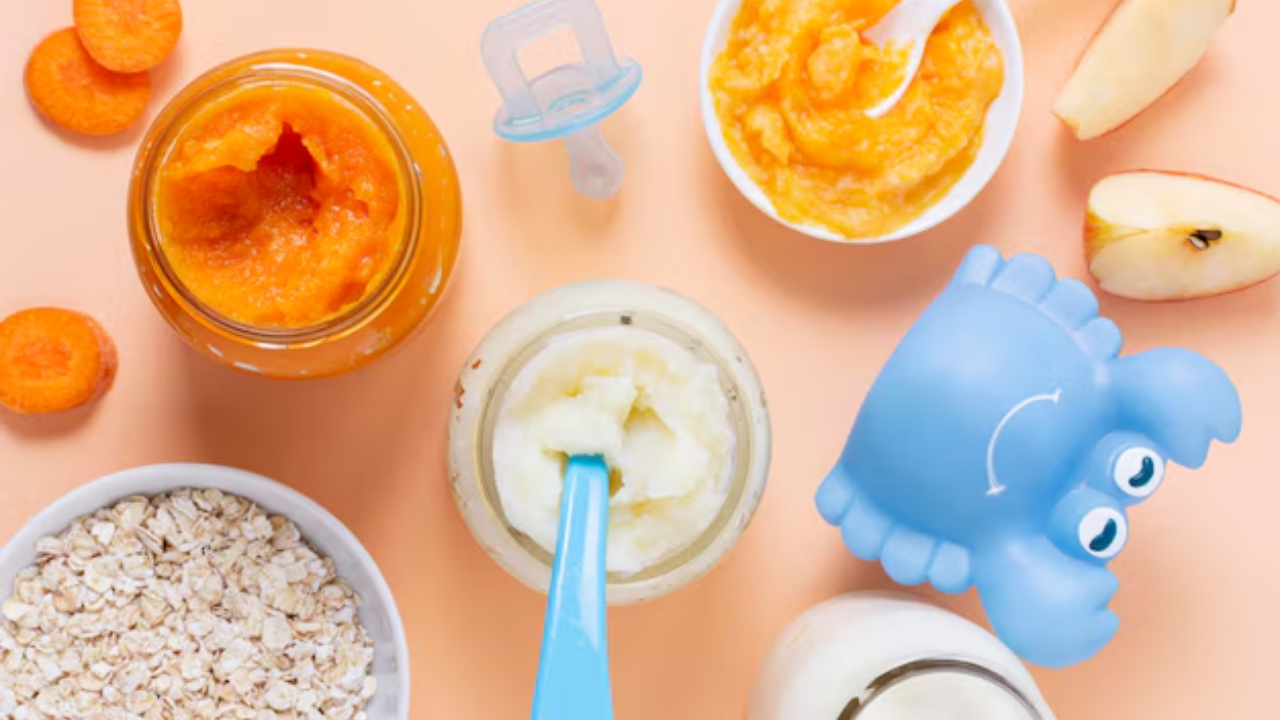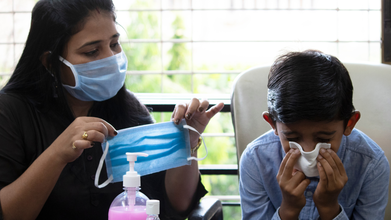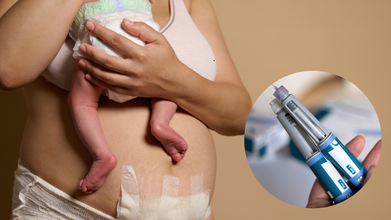- Health Conditions A-Z
- Health & Wellness
- Nutrition
- Fitness
- Health News
- Ayurveda
- Videos
- Medicine A-Z
- Parenting
Add These 12 Superfoods To Your Baby’s Diet For Growth And Optimum Nutrition

Add These 12 Superfoods To Your Baby’s Diet For Growth And Optimum NutritionCredits: Freepik
Food plays an important role in the growth and nutrition of infants or growing toddlers. Since babies are introduced to the world of solid foods around 6 months of age, it is essential to ensure that the right amount of proteins, carbohydrates, calcium, iron and other nutrients are given in their initial period. It often gets challenging for mothers to choose from an array of options but it is recommended to incorporate iron-rich foods to support holistic development and prevent anaemia. For tissue repair, proteins must be added to the diet. Not to forget, for strong teeth and bones, calcium-rich foods must be incorporated. So, we’ve made it easier for you, here’s a compilation of 12 superfoods which are essential for the development of babies. Happy exploring!
Banana
Bananas are the powerhouse of essential nutrients. Since, the initial 5-6 months need a lot of attention, feeding your babies mashed bananas can help build a healthy digestive system and maintain the nutrition in the body. Loaded with carbohydrates and nutrients like Vitamin C, potassium, folate and much more, bananas must be incorporated into the diet.Eggs
This versatile superfood can be your baby’s first step to solid foods. Eggs contain 70 calories with 6 grams of protein which is efficient for growth and development. You can feed eggs at any time of the day in a boiled, scrambled, or poached manner. Eggs boast a healthy amount of phosphorus which is not only beneficial but necessary for the baby.Spinach
From preventing anaemia to providing essential vitamins, Spinach is considered a superfood which helps in the development of the baby. With vitamin A aiding the functioning of the immune system, spinach is the powerhouse of many other nutrients like iron and calcium which are considered essential for your baby’s diet.Sweet Potato
From delectable flavour to essential nutrients, sweet potatoes are a must-have in your baby’s diet. Loaded with vitamins A, B and C, potassium, calcium, and fibre, it is recommended to prepare this carbohydrate-rich food carefully for easy ingestion. You can also combine veggies with the sweet potato which also serves as a great addition.Peas
Peas are considered a great source of carbohydrates, fibre and protein which not only fuel the growth of your baby but also serve as a rich agent in developing healthy metabolism. The presence of zinc and vitamin B6 helps your baby fight against the stressors.
Avocado
With healthy monounsaturated fatty acids, avocados offer a large number of benefits to the babies. From enhancing the brain, eye, and nerve health to essential antioxidants, Avocados are a valuable option and must be included in the diet.Sweet Corn
For a baby’s growth, it is essential to incorporate food items which are rich in essential nutrients. Sweet corn is considered as a good source of vitamins, phosphorous and folate which help promote healthy vision and support a baby’s immune system.Lentils
From being a good source of iron and zinc to many beneficial values, it is considered to introduce small quantities of lentils as it may form excess gas which can disturb the baby. Lentils promote neurological development and wound healing.Yoghurt
Yoghurt is considered as one of the first food items that babies can eat. Yoghurt is loaded with immense health benefits and regular consumption can not only prevent disease-causing bacteria but also treat insomnia in babies.Carrots
Loaded with vitamin A, carrots prevent the baby from getting constipated. Carrots must be blended well to make it easier for the babies to digest. This superfood not only promotes healthy vision but also powers the growth and development of the baby.Brown Rice
Brown rice is considered as a healthy option for the babies. From being a great source of nutrition to having essential antioxidants, the complex carbohydrates promote a feeling of fullness and can definitely be a healthy choice for the young ones.Shredded Chicken
With essential fats and nutrients, chicken must be introduced to your baby’s diet when they are ready to start with the solid food’s journey. The vitamins present in the chicken can boost brain development and promote healthy red blood cells in the body.Note: These superfoods have all the nutrients which are required for the development of the baby. It is recommended to consult your paediatrician for a suitable time to start with these supplements.
Why A Persistent Cough In Children Needs Attention, And Ways To Strengthen Their Immunity, According To Doctor

Credits: iStock
As winter settles in and children move between school, outdoor play, and indoor gatherings, coughs and colds often become unavoidable companions. While many coughs resolve on their own, doctors warn that a cough that lingers for weeks is not something parents should overlook. At the same time, the cold season naturally weakens a child’s defenses, making it important for families to follow simple steps to improve immunity.
When a Cough Lasts Too Long
According to Dr Nishant Bansal, Consultant Pediatrician and Neonatologist at Motherhood Hospitals, Noida, parents must stay alert when a cough stretches beyond the usual duration. He explains, “A cough that lasts for weeks should never be ignored. While many are caused by mild infections, persistent or recurring coughs can point to allergies, asthma, or an underlying health issue.”
Many children are catching respiratory infections during weather changes or after starting school. As temperatures drop, coughs tend to worsen. What may look like a harmless lingering cold could actually be linked to an allergy, asthma, sinusitis, whooping cough, or even exposure to pollutants and smoke.
Dr Bansal adds, “If a child’s cough becomes worse at night, during exercise, or after exposure to dust or pets, it may be triggered by asthma or allergies. These symptoms should be reported to a doctor without delay.” Children exposed to polluted air or cigarette smoke are especially prone to constant coughing and wheezing.
Ignoring these symptoms can interfere with sleep, appetite, growth, and energy levels. Some infections, such as whooping cough or sinusitis, require prompt treatment to prevent complications. That is why early identification of the cause is essential.
Managing and Preventing Persistent Coughs
Parents often try repeated home remedies such as honey, steam, or warm fluids, but these may not be enough. “If the cough lasts more than two to three weeks, it should be evaluated instead of being managed with only home remedies,” says Dr Bansal.
Indoor air quality plays a major role. Avoid smoking around children, improve ventilation, and use an air purifier if possible. Keeping children well hydrated with warm soups, milk, or water can soothe the throat and loosen mucus. Over the counter cough syrups should be avoided unless a doctor prescribes them.
Warning signs such as wheezing, breathing difficulty, coughing fits, or fever need immediate medical care. Timely guidance helps the child breathe better, recover faster, and avoid long term complications.
Why Winter Increases Illnesses in Children
Children are naturally more vulnerable during colder months. They often face sore throats, colds, coughs, and viral infections that spread easily when people gather indoors. Dr Atul Palwe, Consultant Pediatrician and Neonatologist at Motherhood Hospital, Lullanagar, Pune, explains, “Viruses spread more easily in winter, especially when children stay in closed spaces for long hours.”
Strengthening immunity is key to helping children stay healthy throughout the season.
Simple Ways to Boost a Child’s Immunity
Focus on a Nutritious Diet
“A strong immune system begins with a balanced diet,” says Dr Palwe. He recommends plenty of fruits, vegetables, whole grains, legumes, nuts, and seeds. Foods rich in vitamin C such as oranges, guavas, and amla, along with zinc and iron rich foods, help build resistance.
Maintain Hydration
Children tend to drink less water in winter, but staying hydrated helps the body remove toxins. Warm soups and milk are comforting alternatives.
Encourage Regular Activity
Indoor games, yoga, and outdoor play on pleasant days improve blood circulation and strengthen immunity.
Ensure Adequate Sleep
“Children under ten need about ten to twelve hours of sleep every night to keep their immunity strong,” says Dr Palwe.
Teach Hygiene Habits
Handwashing before meals, after play, and covering the mouth while coughing reduces the spread of infections.
Dress Them Warmly
Layering helps protect children from cold winds while still allowing movement.
Get Enough Vitamin D
Limited sunlight in winter can affect vitamin D levels. Dr Palwe suggests encouraging morning outdoor play or discussing supplements with a doctor if needed.
Older, Younger or Middle Child: Does Birth Order Shape Your Personality?

Credits: iStock
Are you a younger sibling in your family and you relate to other younger siblings? Do you feel some of your habits and traits match other younger siblings? Or are you the middle child and you feel that sometimes you are excluded. When you talk about it, other middle children also agree with you. If this is the case with you, then you may be interested to know the Birth Order Theory.
This theory was developed by Alfred Adler in 1964, who focused on the importance of birth order on personality development. In this theory, he says that though children may be born into the same household, their birth order greatly influence their psychological development.
As per Adler's birth order theory, a child could have certain personality traits which are as followed:
- The Oldest Child: more authoritarian, and feels powerful due to high expectations set by the parents
- The Youngest Child: treated like a spoiled baby and cannot rise above the other siblings
- The Middle Child: even tempered, but has trouble fitting in as they have always been sandwiched between the younger and the older siblings
However, for middle child, their characteristics would often get itself a term, called the Middle Child Syndrome.
What Exactly Is A Middle Child Syndrome And What Sets Them Apart From Their Younger And Older Siblings?
Middle child syndrome is the belief that middle children are excluded, ignored, and neglected because of their birth orders.
People often talk about “middle child syndrome,” the idea that the child who is neither the oldest nor the youngest develops a very particular personality. While some of this comes from family dynamics rather than science, many families do notice certain patterns.
Personality Traits
Middle children sometimes feel overshadowed by their siblings. The oldest is often seen as responsible and strong-willed, while the youngest gets extra attention for simply being the baby of the family. The middle child may end up somewhere in the middle of all this, which can make them quieter, more even tempered, and sometimes unsure of where they fit in.
Family Relationships
When it comes to parents, middle children might feel that they do not get the same level of attention as their siblings. The older child usually carries more responsibility, and the younger child often gets extra care and protection. The middle child may feel they slip through the cracks and receive less one-on-one time with their parents.
Sibling Rivalry
Feeling unseen can spark a sense of competition. Many middle children find themselves competing for attention from both parents and siblings. At the same time, they often become the peacemaker of the family simply because they are used to being in the middle of everything.
Feeling Left Out of Favoritism
When parents unintentionally favor the oldest for their achievements or the youngest for their sweetness, the middle child may feel they are no one’s first pick. They are not the trailblazer or the baby, and this can shape how they see their place in the family.
Carrying These Feelings Into Adulthood
Some people believe that these early experiences can follow middle children into adulthood. If a middle child grew up feeling overlooked, they might struggle with co dependency or constantly try to keep the peace in relationships. They may also find it difficult to believe they can be someone’s closest friend or favorite person.
Their personalities often seem muted when it is compared to the other siblings, this is because they have always blended into the background. These patterns can show up at work, in friendships, and in romantic relationships.
What Research Actually Shows
Although middle child syndrome is talked about a lot, scientific research has not clearly confirmed it. There have been studies that show some truth to the theories, while others deny. Some research suggests that middle children do feel less close to their parents or are less likely to turn to their parents when they are going through stressful times in their lives. A 2019 study showed that middle children were less likely to feel comfortable talking to their parents on topics like sex education. Though it is important to note that this is a broad topic to begin with, and could have cultural variations.
Other studies have suggested they might be less family oriented or more prone to certain perfectionistic traits. But these findings are not consistent across research. In fact, a number of large studies show no strong link between birth order and major personality traits such as extraversion, emotional stability, or agreeableness.
Some studies even contradict each other entirely. For instance, one study suggested middle children might have a higher risk of depression, while another found that oldest children were more likely to experience mental health issues.
So Does Middle Child Syndrome Exist?
With so many conflicting findings, scientists cannot say for sure. Many experts believe that personality is shaped by a mix of family environment, parenting styles, cultural background, and individual temperament. Birth order may play a small role, but it is unlikely to be the determining factor.
In short, middle child syndrome is more of a popular idea than a proven scientific fact. Each child’s experience is unique, and many different influences shape who we become.
More New Moms Turning to Ozempic After Birth, But Experts Are Worried

Credits: iStock
Danish researchers were studying the use of medicines on women during and after pregnancy. What they realized is that number of women consuming Ozempic and Wegovy after childbirth has increased. As per their observation, in 2018, less than 5 prescriptions for every 10,000 women post six months of their childbirth were there. However, this number increased to 34 in mid-2022, and by mid-2024, there were 173 prescriptions.
That comes close to 2 percent of all postpartum women. Most of these women were in their 30s, had more than one child, and while many were overweight, they did not have diabetes. They also had no previous history of using GLP-1 medications.
This spike surprised researchers because the postpartum phase is usually a time when the body naturally sheds some pregnancy weight and undergoes major hormonal changes. “In a period characterized by natural weight loss and marked hormonal change, this was unexpected,” said Mette Bliddal, a pharmacologist at the University of Southern Denmark and the study’s first author, as reported by the New York Times. The findings were published in JAMA.
How Was The Study Conducted?
The analysis reviewed 382,277 pregnancies in Denmark from early 2018 through June 2024. Researchers used national health registries to track every live birth and every prescription filled for GLP-1 drugs during the postpartum period. This made it possible to see the rise in real time.
Although semaglutide, the ingredient in Ozempic and Wegovy, is widely used for weight loss, its safety in the months after childbirth is still unclear. This is a time when many mothers are breastfeeding and adjusting to changing hormone levels, sleep disruptions, and recovery from pregnancy.
What We Know and Don’t Know About Breastfeeding Safety
Right now, evidence around the safety of GLP-1 drugs for breastfeeding mothers is very limited. While semaglutide has not been detected in measurable amounts in breast milk and no immediate negative effects have been seen in infants, researchers caution that long-term effects on a baby’s metabolism, growth, or pancreas remain unknown.
Major medical groups are also hesitant to give a firm recommendation. The American College of Obstetricians and Gynecologists has not released guidelines because the drugs are too new and the data isn’t strong enough. First Exposure, a Canadian research network that evaluates drug safety in pregnancy and breastfeeding, advises against using these medications while breastfeeding. They also recommend stopping them one to two months before trying to conceive.
Experts say the caution comes from the lack of solid research. GLP-1 drugs are large molecules that usually do not transfer easily into breast milk and would likely break down in a baby’s stomach. Still, the uncertainty is significant enough that researchers prefer mothers avoid them during breastfeeding.
Why Researchers Are Concerned
Another concern is that these appetite-suppressing medications could affect milk production, nutrient content, or even leave mothers dehydrated. Dr. Bliddal noted that the postpartum period is a time when “the body is working hard to regain its balance.” Without knowing how weight loss drugs interact with these processes, many specialists believe it is safer to avoid them until more is known.
Even small changes in breast milk composition could matter for infant development. Since there is no clear data on how GLP-1 drugs might alter fat content or nutrients in breast milk, researchers urge caution.
© 2024 Bennett, Coleman & Company Limited

